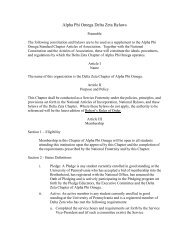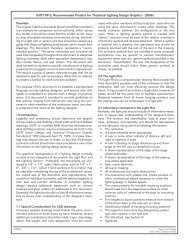Penn Philosophical Perspectives - University of Pennsylvania
Penn Philosophical Perspectives - University of Pennsylvania
Penn Philosophical Perspectives - University of Pennsylvania
- No tags were found...
Create successful ePaper yourself
Turn your PDF publications into a flip-book with our unique Google optimized e-Paper software.
<strong>of</strong> restrictions, rules, or constraints that are meant to describethe real world in some way. However, the connection with thereal world goes by way <strong>of</strong> models, which are abstract (possiblymathematical) objects that satisfy the constraints <strong>of</strong> the theory.Scientists then compare these models with the world, and usethe similarities and discrepancies to better understand our worldand our theories <strong>of</strong> it.Idealization and Information CompressionIn constructing models, scientists must not only concernthemselves with their correctness or the degree to which theyture<strong>of</strong> a physical system, while it would give us a great deal <strong>of</strong>information about that system, would be hopelessly complexgive as much information as possible about their physical ana- glectaspects <strong>of</strong> a system that have small effects or do not affectthe target system in ways that matter for the current analysis.For example, in high school physics, we calculate the distancea ballistic projectile will travel when launched at some speedand angle without regard to the air resistance, since it has anegligible effect on the outcome. Such calculations give us verylittle more information, but complicate the model immensely(remember that air resistance is proportional to the velocity, thespeed and direction <strong>of</strong> the air, and the cross-section <strong>of</strong> the object).Therefore, we abstract away such aspects <strong>of</strong> the worldglectthese features, since they have minimal effect on the outcome,but a large effect on the effectiveness <strong>of</strong> the model. creation is the compression <strong>of</strong> information. The mathematics<strong>of</strong> information compression grew out <strong>of</strong> the work <strong>of</strong> Turing,Kolmogorov and Chaitin, and rely on the fact that much informationin the world comes in repeating patterns. For example,consider the two strings below.b = 01010101010101010101January 2010<strong>Penn</strong> <strong>Philosophical</strong> <strong>Perspectives</strong>Here, a looks simply like a random string <strong>of</strong> twenty digits,which it in fact is. b, on the other hand, looks more ordered, simpler,or patterned. The information contained in b can be com-bcourse, this does not really compress the information much, butif b was ten billion pairs <strong>of</strong> ‘01,’ then such a description wouldcontain the information in b much more succinctly. However,because a is a random string, there is no pattern that we cancompress, nothing we can take advantage <strong>of</strong> to condense a intoa more easily used string.This compression <strong>of</strong> information is <strong>of</strong> the utmost impor- physical world, ones that must be simpler and easier to use.Compressing information by encoding regularities helps usbuild small models that deal with a great deal <strong>of</strong> simple phenomena,such as linear relationships and low-period behavior. information compression does not much help us in the case <strong>of</strong>complex systems.Simple Versus Complex SystemsHaving covered the fundamentals <strong>of</strong> modeling in science,the next section will elucidate the differences between simplecomplexity that we most wish to capture in our models are infact the biggest hindrances to doing so.Simple systems are almost always synonymous with lin-tion<strong>of</strong> two solutions is itself a solution. Formally, if x(t) andy(t) are two solutions, then ax(t) + by(t) is also a solution, forany scalar a and b. This property is extremely convenient; it al-that the systems are ‘well-behaved’ in other respects as well.The most important behavior <strong>of</strong> such linear systems for us isthat they asymptotically approach only three kinds <strong>of</strong> behavior,these behaviors the system will approach.Complex, or nonlinear, systems, stand in stark contrast to have guessed, it is not generally the case that a linear combina-are no guarantees about the asymptotic behavior <strong>of</strong> complexsystems. However, there are two aspects <strong>of</strong> complex systemsthat are most important for the purposes <strong>of</strong> this paper, and sodeserve sections <strong>of</strong> their own.Sensitive Dependence on Initial Conditions lated,most researchers agree that complex systems contain anelement <strong>of</strong> chaos. Used in this way, chaos does not refer to completedisorder, but to a sensitive dependence on initial conditions.This means that any slight disturbance in the system isdifferent state than if it had not been disturbed. the following map, x n+1= x n n), called the logistic map. a small amount. However, we can see that the differences betweenthe two trajectories on the map are becoming larger, afteronly four iterations.It can be shown that initial conditions to these kinds <strong>of</strong>systems diverge exponentially, so that they are eventuallycompletely different. This sensitive dependence on initial conditionsis generally understood as a stretching and folding <strong>of</strong>plexsystems has a fractal structure, so that it is incredibly dif-further implies that it is very hard to show which <strong>of</strong> the attractorregions the systems approaches at the limit. This is exactly whywe cannot know what the long-term behavior <strong>of</strong> a complex systemwill be.12
















